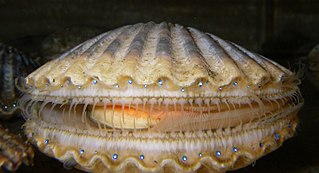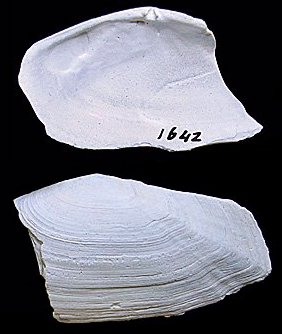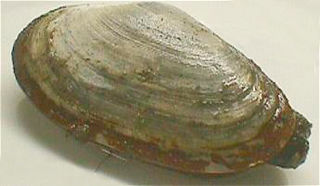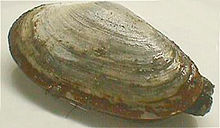
A seashell or sea shell, also known simply as a shell, is a hard, protective outer layer usually created by an animal or organism that lives in the sea. Most seashells are made by mollusks, such as snails, clams, and oysters to protect their soft insides. Empty seashells are often found washed up on beaches by beachcombers. The shells are empty because the animal has died and the soft parts have decomposed or been eaten by another organism.

Bivalvia or bivalves, in previous centuries referred to as the Lamellibranchiata and Pelecypoda, is a class of aquatic molluscs that have laterally compressed soft bodies enclosed by a calcified exoskeleton consisting of a hinged pair of half-shells known as valves. As a group, bivalves have no head and lack some typical molluscan organs such as the radula and the odontophore. Their gills have evolved into ctenidia, specialised organs for feeding and breathing.

A siphon is an anatomical structure which is part of the body of aquatic molluscs in three classes: Gastropoda, Bivalvia and Cephalopoda.

Venerida is an order of mostly saltwater but also some freshwater bivalve molluscs. This order includes many familiar groups such as many clams that are valued for food and a number of freshwater bivalves.
Dreissenoidea is a superfamily of brackish water and freshwater false mussels, aquatic bivalve molluscs in the order Myida.

The Arcida is an extant order of bivalve molluscs. This order dates back to the lower Ordovician period. They are distinguished from related groups, such as the mussels, by having a straight hinge to the shells, and the adductor muscles being of equal size. The duplivincular ligament, taxodont dentition, and a shell microstructure consisting of the outer crossed lamellar and inner complex crossed lamellar layers are defining characters of this order.

The Pteriomorphia comprise a subclass of saltwater clams, marine bivalve molluscs. It contains several major orders, including the Arcida, Ostreida, Pectinida, Limida, Mytilida, and Pteriida. It also contains some extinct and probably basal families, such as the Evyanidae, Colpomyidae, Bakevelliidae, Cassianellidae, and Lithiotidae.

Palaeoheterodonta is a subterclass of bivalve molluscs. It contains the extant orders Unionida and Trigoniida. They are distinguished by having the two halves of the shell be of equal size and shape, but by having the hinge teeth be in a single row, rather than separated into two groups, as they are in the clams and cockles.

Heteroconchia is a taxonomic infraclass of diverse bivalve molluscs, belonging to the subclass Autobranchia.
A molluscivore is a carnivorous animal that specialises in feeding on molluscs such as gastropods, bivalves, brachiopods and cephalopods. Known molluscivores include numerous predatory molluscs,, arthropods such as crabs and firefly larvae, and, vertebrates such as fish, birds and mammals. Molluscivory is performed in a variety ways with some animals highly adapted to this method of feeding behaviour. A similar behaviour, durophagy, describes the feeding of animals that consume hard-shelled or exoskeleton bearing organisms, such as corals, shelled molluscs, or crabs.

The Psammobiidae, or sunset clams, are a family of medium-sized saltwater clams, marine bivalve molluscs of the order Cardiida.

Unionida is a monophyletic order of freshwater mussels, aquatic bivalve molluscs. The order includes most of the larger freshwater mussels, including the freshwater pearl mussels. The most common families are the Unionidae and the Margaritiferidae. All have in common a larval stage that is temporarily parasitic on fish, nacreous shells, high in organic matter, that may crack upon drying out, and siphons too short to permit the animal to live deeply buried in sediment.

Anomalodesmata is an superorder of saltwater clams, marine bivalve molluscs. This grouping was formerly recognised as a taxonomic subclass. It is called a superorder in the current World Register of Marine Species, despite having no orders, to parallel it with sister taxon Imparidentia, which does have orders.
Freshwater bivalves are molluscs of the order Bivalvia that inhabit freshwater ecosystems. They are one of the two main groups of freshwater molluscs, along with freshwater snails.

Myidae, common name the softshell clams, is a taxonomic family of marine bivalve molluscs in the order Myida.

Freshwater molluscs are those members of the phylum Mollusca which live in freshwater habitats, both lotic such as rivers, streams, canals, springs, and cave streams and lentic such as lakes, ponds, and ditches.

Protobranchia is a subclass of bivalve molluscs. It contains the extant orders Nuculanida, Nuculida, and Solemyida.

Pectinida is a taxonomic order of large and medium-sized saltwater clams, marine bivalve molluscs, commonly known as scallops and their allies. It is believed that they began evolutionarily in the late Middle Ordovician epoch; many species, of course, are still extant.
Potamocorbula amurensis is a species of small saltwater clam, a marine bivalve mollusc in the order Myida. Common names include the overbite clam, the Asian clam, the Amur River clam and the brackish-water corbula. The species is native to marine and brackish waters in the northern Pacific Ocean, its range extending from Siberia to China, Korea and Japan. It has become naturalised in San Francisco Bay.














